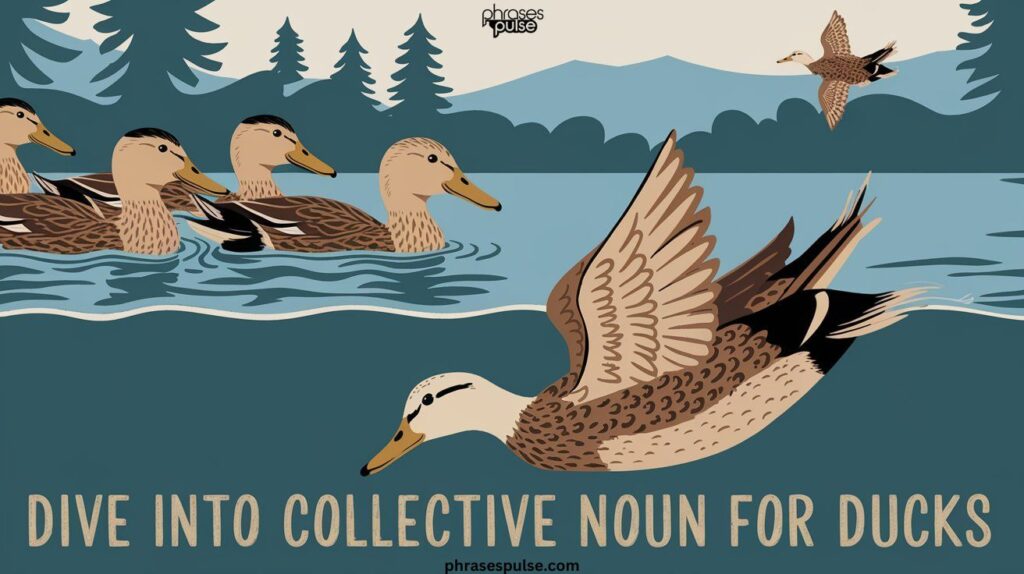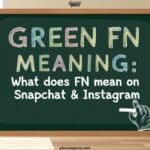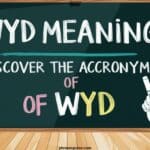Collective noun for ducks refers to the fascinating and specific terms used to describe groups of ducks depending on their location and behavior. Whether they’re quacking and waddling on land, gracefully swimming on a lake, or flying in formation, these unique words offer a glimpse into the world of these aquatic birds.
More than just enriching our vocabulary, these terms capture the essence of duck behavior in nature. From ducks gliding across the water to migrating as a group, each collective noun tells a story of observation, language, and nature’s beauty.
What Is a Collective Noun?
A collective noun is a word used to refer to a group of people, animals, or things as a single entity. For example, we use “team” to describe a group of players and “herd” for a group of cattle. In the animal world, each species often has its own unique collective noun, and ducks are no exception.
Understanding these terms allows us to communicate more precisely, whether we’re birdwatching or simply enjoying a walk in nature. Collective nouns for ducks are particularly fascinating because they change depending on the environment and behavior of the ducks.
Collective Noun for Ducks
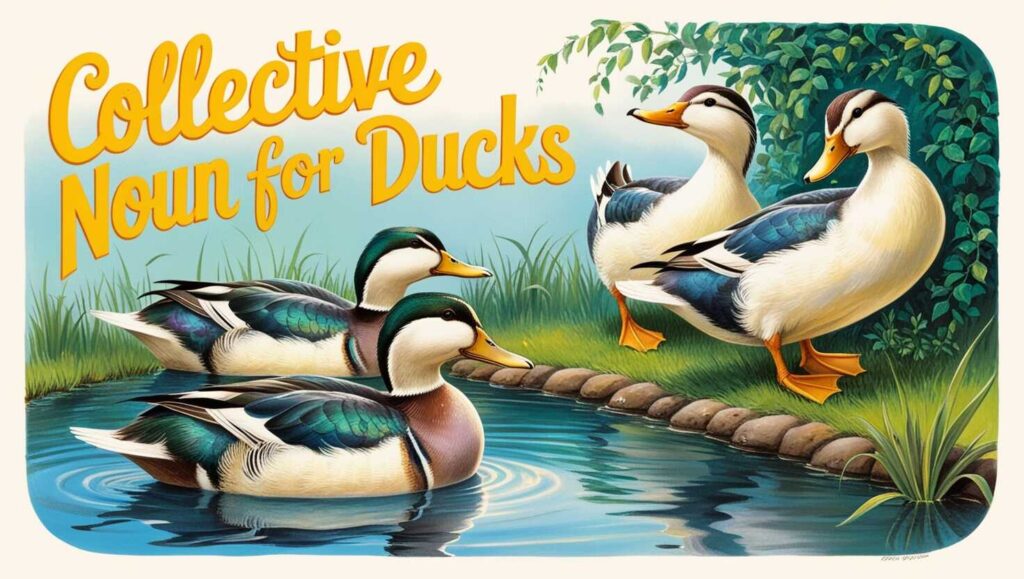
Below is a list of 10 collective nouns for ducks, each tied to specific behaviors, habitats, or scenarios. From ducks on water to ducks in the air, this list offers a vocabulary enhancement that will deepen your understanding of both language and waterfowl.
| Collective Noun | When It’s Used | Description |
|---|---|---|
| Raft of Ducks | Ducks on water | Ducks floating together in a group on water, appearing like a “raft.” |
| Flock of Ducks | Ducks on land or in flight | Ducks gathered on land or flying as a large group. |
| Skein of Ducks | Ducks flying in a V-formation | Ducks flying in formation, often during migration. |
| Paddling of Ducks | Ducks swimming in water | Ducks actively swimming, with their feet paddling beneath them. |
| Brace of Ducks | A pair of ducks | Typically used for a pair of ducks, especially in hunting or breeding contexts. |
| Team of Ducks | Ducks working together in flight | Ducks flying in close coordination, often moving as a unit during migration. |
| Badling of Ducks | A family or group of young ducks | A lesser-known term for a group of ducklings or young ducks. |
| Company of Ducks | Ducks on water or in the air | Ducks traveling together in a friendly, social manner. |
| Herd of Ducks | Ducks foraging on land | Ducks moving together on land, often searching for food. |
| Flight of Ducks | Ducks flying at any height | A general term for ducks in the air, especially in non-V formations. |
collective noun for ducks explanation with examples
Raft of Ducks
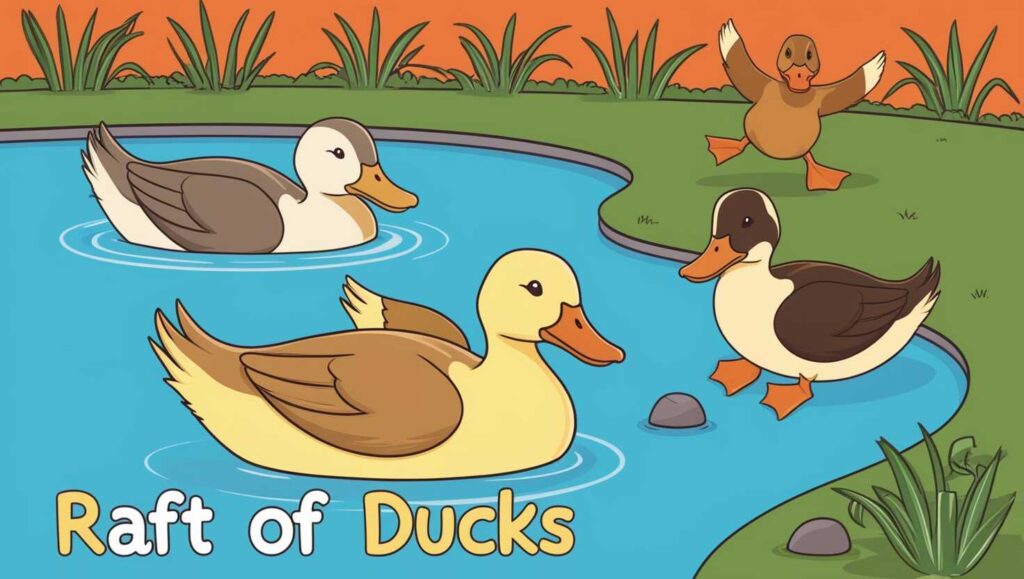
A raft of ducks refers to a group of ducks floating together on water. This term is inspired by the way ducks often congregate closely on lakes, ponds, or rivers, forming a tight cluster that resembles a raft. Ducks float together for safety, as there is strength in numbers when it comes to avoiding predators.
Why Is It Called a Raft?
The term “raft” highlights the way ducks create a solid, unified group while on water, much like a raft made of logs tied together. This behavior is commonly observed in calm water settings, where ducks float peacefully, rest, or feed.
Example in Context:
“As the sun set over the lake, a raft of ducks drifted gently along the surface, their heads tucked under their wings.”
Flock of Ducks
Flock of ducks is a versatile term that can describe ducks either on land or in flight. You’re most likely to hear “flock” when referring to ducks foraging on land or flying in large groups. This term is shared with many other bird species, including geese and pigeons.
Example in Context:
“The flock of ducks gathered by the shore, their heads bobbing as they pecked for food.”
Skein of Ducks
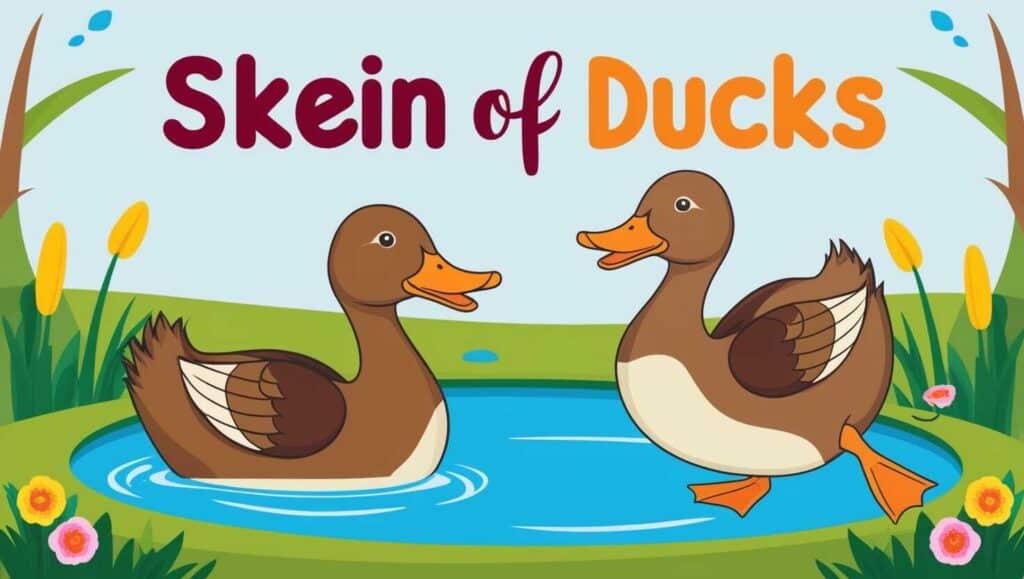
When ducks take to the sky in their iconic V-formation, they form a skein of ducks. This collective noun is specific to ducks in flight and refers to the weaving, thread-like appearance of the V-shape as they soar across the sky. This formation helps ducks conserve energy during long migrations.
Example in Context:
“A skein of ducks flew overhead, their V-formation cutting through the crisp autumn air as they began their migration south.”
Paddling of Ducks
A paddling of ducks refers to ducks swimming in water, with the focus being on their paddling feet. This term emphasizes the action of the ducks as they move through the water, often observed in ponds or slow-moving rivers.
Example in Context:
“A paddling of ducks swam toward the reeds, their webbed feet moving swiftly beneath the surface.”
Brace of Ducks

Brace of ducks is a term often used in hunting or breeding contexts and refers to a pair of ducks. The word “brace” comes from an old English term meaning “pair,” and it’s commonly used for game birds like ducks, pheasants, or grouse.
Example in Context:
“The hunter carefully approached a brace of ducks resting near the marsh.”
Team of Ducks
A team of ducks describes ducks flying or working together in a coordinated effort, particularly during migration. This term highlights their teamwork, as ducks rely on each other to navigate long distances during seasonal migrations.
Example in Context:
“The team of ducks flew in perfect formation, their migration path guided by instinct and teamwork.”
Balding of Ducks

A balding of ducks is a lesser-known term used to describe a group of young ducks or ducklings. This term is less common but is an interesting addition to your vocabulary for describing baby ducks.
Example in Context:
“A balding of ducklings followed their mother closely, sticking together for protection.”
Company of Ducks
A company of ducks can refer to ducks either in the water or in the air. This term emphasizes the social, friendly nature of ducks when they travel in groups. Whether they’re flying or swimming, ducks exhibit strong social bonds, making “company” an apt term.
Example in Context:
“A company of ducks landed gracefully on the pond, their feathers glistening in the sunlight.”
Herd of Ducks
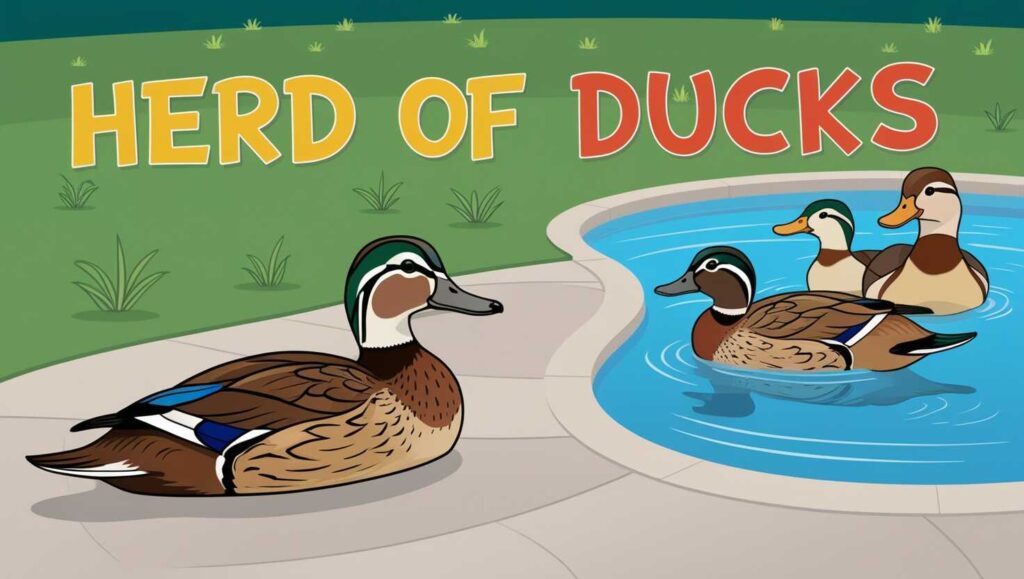
Herd of ducks is an unusual but acceptable term, especially when ducks are on land and foraging together. This term highlights their land-based activities, such as searching for food or waddling across fields.
Example in Context:
“A herd of ducks waddled across the open field, pecking at the grass for insects.”
Flight of Ducks
A flight of ducks is a general term used to describe ducks in the air, particularly when they aren’t in a distinct V-formation. This term captures the elegance and grace of ducks flying together.
Example in Context:
“As the sun dipped below the horizon, a flight of ducks soared across the sky, their wings beating rhythmically.”
Vocabulary Enhancement Through Duck Terminology
Understanding these collective nouns for ducks enhances your word knowledge and deepens your connection with nature. The language of the animal kingdom is filled with rich, descriptive words that reflect the behaviors and environments of wildlife. Learning these terms gives us a greater appreciation of ducks and the way they live, whether they’re floating, flying, or foraging.
These terms also contribute to lexicon growth, as each one adds a new layer of understanding to the way we communicate about animals. Using the correct terminology, such as “skein” or “brace,” elevates your conversation and knowledge about these fascinating birds.
Conclusion
Ducks are more than just charming creatures; they inspire a diverse and colorful language. From a raft of ducks floating peacefully on a lake to a skein of ducks migrating in perfect formation, each collective noun offers a glimpse into the lives of these waterfowl. By understanding these terms, you not only enrich your vocabulary but also form a stronger nature connection, appreciating the beauty and behavior of ducks in their natural habitats.
Next time you see a flock of ducks on land or a paddling of ducks swimming in a pond, you’ll know exactly what to call them and why these words matter. This duck discovery into collective nouns is just the beginning of a wildlife admiration that enhances both your language skills and your connection to the natural world. So, keep observing, learning, and using these terms to impress your friends, enhance your language, and deepen your bond with nature!

Ava Rose, the creator of PhrasesPulse, is an expert in English grammar with years of experience. She is dedicated to simplifying complex grammar rules and exploring the richness of English phrases. Through her insightful posts, Ava aims to help learners of all levels enhance their understanding of the language and communicate more effectively. Her passion is making grammar approachable and enjoyable for everyone.

